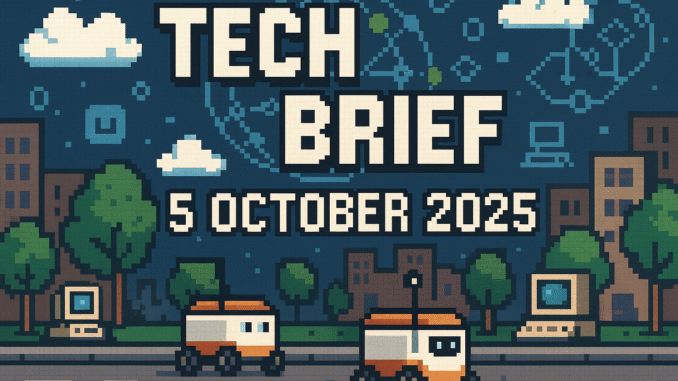
“Tech Brief 5 October 2025” spotlights humans, history, and code in equal measure. Over machine learning and digital delivery, the real drama is always about people, not platforms. Today’s stories cover everything from robotics on your doorstep to the growing fight over digital content, with a nod to the open-source rebels who shook things up from the start.
Missed yesterday’s Tech Brief? Catch up here before diving in.
Skype Co-Founder’s Starship Robots Target Small-Town Delivery
“People said the internet would never change post,” says Ahti Heinla, now leading Starship Technologies. Starship’s autonomous delivery bots are finding profitable routes in UK towns too small for traditional courier economics. Heinla, armed with the same restless energy that made Skype ubiquitous, promises a future where convenience reaches the community shop, often written off by Silicon Valley.
Critics recall earlier British projects like the Sinclair C5, but the technology group points out modern sensors, AI routing, and more practical packaging. The robots handle daily obstacles: kerbs, bins, even the odd skateboarding youth. As retail adapts and postal staff retire, these robots could transform high streets and Saturday mornings. If nothing else, it’s a test of how much patience Brits really have for traffic-calming bumps and occasional runaway sandwiches.
UK Invests £1 Million to Boost Regional Tech Hubs
The government is tipping £1 million into fourteen regional digital projects, providing overdue recognition for UK innovation that grew outside London’s orbit. This is the first time in years that public funds have targeted grass-roots computing instead of just headline-grabbing start-ups.
From Dumfriesshire coders to Welsh gaming clusters, legacy meets new imagination. The regions that once gave us Acorn, Sinclair, and DMA Design now receive support for fresh digital businesses, cutting across education, green tech, and local manufacturing.
Despite the headlines, this isn’t new. Britain’s technical successes have always bubbled up from community circles, school labs, and the odd scout hut on a rainy Thursday. Real progress means making space for ideas seeded far from Silicon Roundabout. If we get another “Lemmings” out of it, that’s a bonus.
OpenAI Sora App to Let Rights Holders Control AI-generated Content
Facts first: OpenAI is rolling out new controls for its Sora video app, allowing rights holders to decide how their characters appear and get paid if their IP is used in AI-generated content. This marks a shift after years of “train first, ask forgiveness later” in the AI playbook.
For anyone who traded demo scene gifs or watched old cartoons copied onto VHS, the stakes might feel familiar. Industries still argue about who owns a version of Sonic the Hedgehog that never even existed until a neural net spat it out. Users will soon notice warnings, royalty prompts, or even blocked scene generation, raising the bar for nostalgic mashups and homemade tributes.
The debate is far from over. Are we heading for another wave of “Napster moments” in the creative industries, or a workable model to keep original creators in business?
From the Wayback Machine
On This Day: 1991, the first official Linux kernel was released. Linus Torvalds shared Linux 0.02 on an Usenet group, offering a free, open UNIX alternative when commercial options dominated. Hacking, customising, and sharing were encouraged. Just over 10,000 lines of code started a movement that became today’s backbone for everything from Raspberry Pis to cloud servers.
What This Means
Tech Brief 5 October 2025 is a reminder that each tool, from autonomous robots to collaborative kernels, is shaped by stubborn people, not faceless systems. Whether you’re eyeing a Starship bot on your doorstep or wondering if your AI mashup will get blocked, the power to change tech still lies close to home.
Keep your soldering iron nearby, but don’t forget the joy of a new GBP keycap or a well-thumbed manual. Explore, restore, and poke at a kernel today.
Missed yesterday’s Tech Brief? Catch up here

Leave a Reply